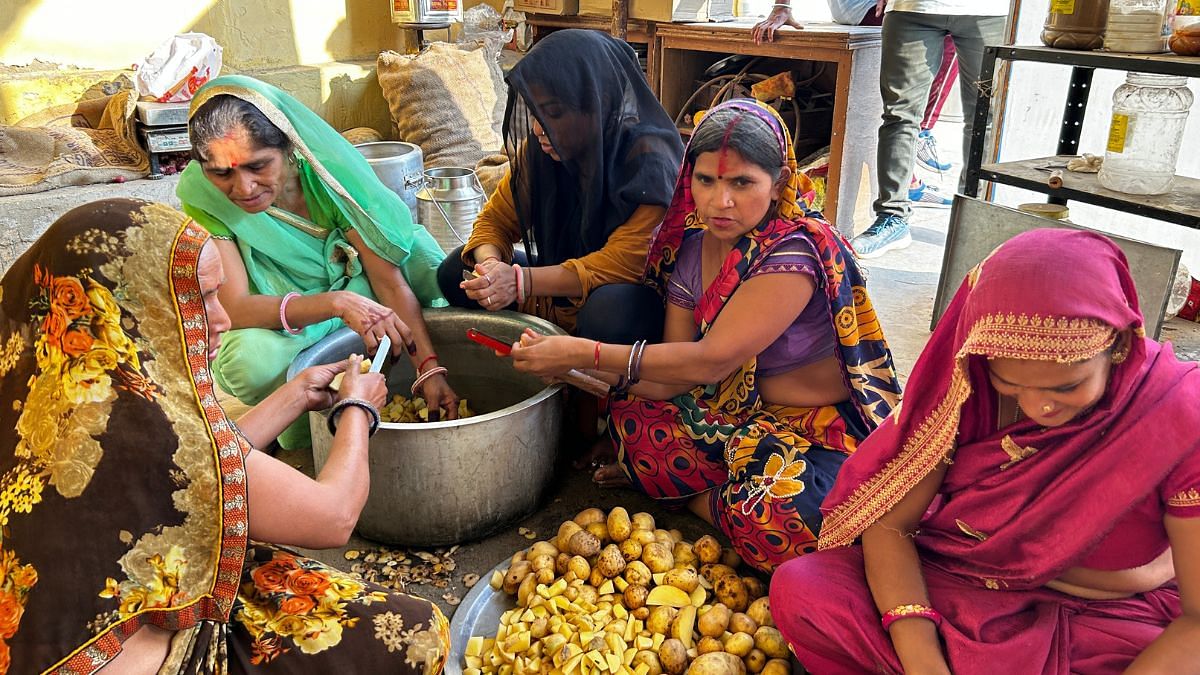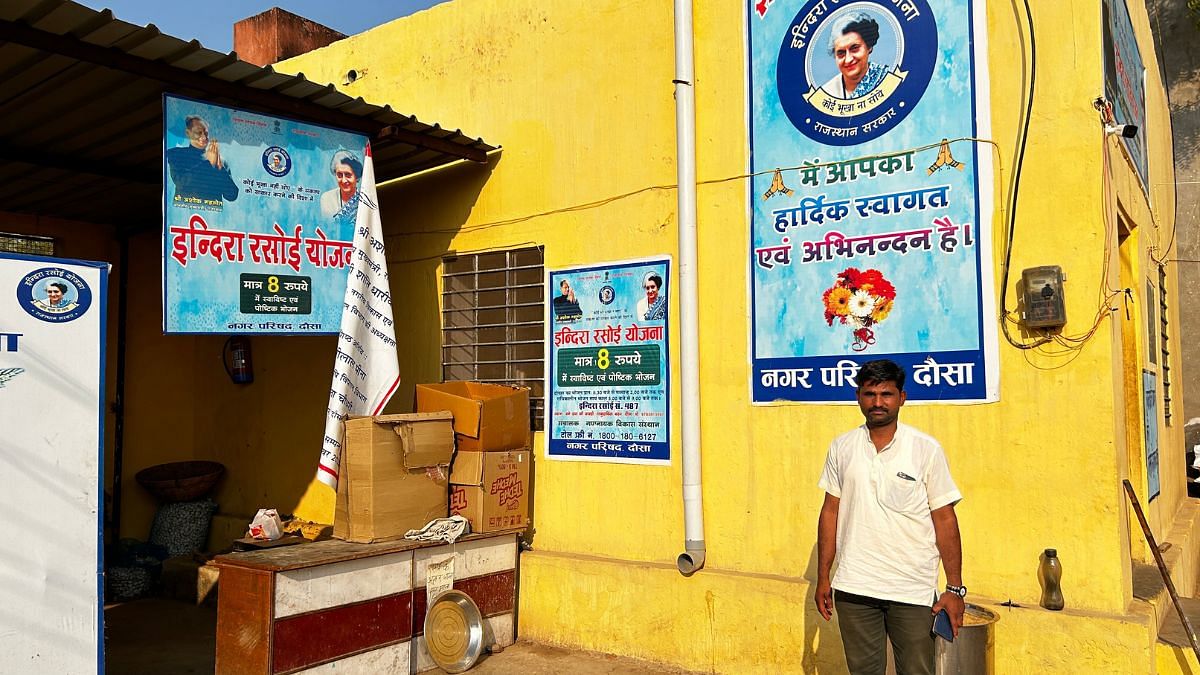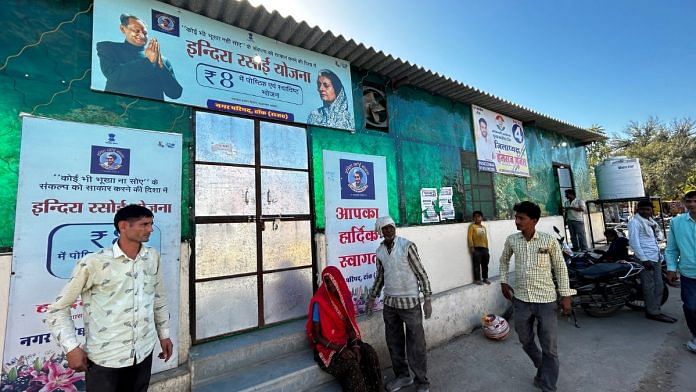Dausa/Tonk: The shabbily dressed Shambhu Lal, 72, is homeless. He dines with 25-year-old gig worker Harish Kumar. They are served a thali full of kadhi, aloo gobhi, pickle and six rotis.
Kumar asks for more. Lal wipes the plate clean.
The two are not friends, and unlikely to be. But for a brief 20 minutes, they sat together at the Indira Rasoi in Dausa’s Bandikui Tehsil in Rajasthan. And then they part ways. The thali cost them Rs 8 each. Kumar paid from what he had earned that day, but Lal was penniless. The Indira Rasoi owner covered for him from his own pocket.
This semi-rural rasoi or canteen, which offers a nutritious meal at a throwaway price to around 400 people every day, is part of a Rs 100 crore flagship scheme Indira Rasoi Yojna launched by the Ashok Gehlot government in August 2020 and feeds millions of urban poor in Rajasthan. But in the two-and-a-half years of operation, they’ve emerged as a lifeline also for Class IV employees of municipalities, migrants, gig workers and even police constables.
The opposition calls it a populist scheme but the Gehlot government is on a mission — Koi bhookha na soye (no one sleeps hungry). Among dozens of his flagship welfare schemes, Indira Rasoi is the cherry on the top, touching millions of lives daily.
Mukesh Kumar (44) runs two Indira Rasois in Dausa city and marked his daughter’s birthday by ‘treating’ patrons to a free plate of food. He says it is becoming a trend.
“I paid for 200 coupons. Others have also started coming on special occasions and buying coupons for the poor to celebrate special days. Even politicians have started doing it as a part of their charity work and reaching out to voters. In the end, it is about feeding those who can’t afford food,” he said.
Also Read: India’s real food problem isn’t hunger but loss and wastage
A democratic idea
Stated-funded canteen for the poor is one of the go-to populist schemes that political parties across India have implemented, with varying levels of success.
In 2013, then-Tamil Nadu chief minister J Jayalalithaa launched Amma Canteens. Chhattisgarh and Jharkhand have implemented Daal-Bhat schemes and Karnataka rolled out Indira Canteens in 2018. The Arvind Kejriwal government in Delhi, too, announced to bring Aam Aadmi canteens in 2015 to replace the Congress’ Jan Ahaar project, but it never took off.
The Gehlot government launched Indira Rasois on 20 August 2020 with 358 canteens across 213 urban local bodies. Today, there are 950 functional Indira Rasois. Each plate has 100 grams of dal, 100 grams of seasonal vegetables and six chapatis along with a serving of pickle. It costs Rs 17, but a patron pays Rs 8; the government subsidises the remaining amount.
In the 2022 budget, the government said it plans to increase the number of kitchens to 1,000. In the 2023 budget, the Gehlot government announced its plans to take this initiative to the rural belt as well.
And while these schemes are popular with the masses, they’ve also been plagued by occasional reports of poor food quality, rise in prices, and lack of political trust when there is a change of guard.
Last year, Gehlot requested MPs, MLAs and other public representatives to monitor the quality of food served and eat in a canteen at least once a month. But soon after the appeal, a video from Rajasthan’s Bharatpur went viral on social media where pigs were seen licking the utensils at an Indira Rasoi. Opposition party leaders used it to criticise the Congress government for failing to ensure even basic hygiene.
In a politically charged Karnataka ahead of the assembly election, the Congress has accused BJP of ‘destroying’ Indira Canteens by not allocating funds.
Economist and social scientist Jean Dreze calls these schemes democratic in nature and argues for the need to establish more such canteens. “These kinds of schemes can be feasible in the long run; all they require is political backing,” he told ThePrint.
The central government was also considering the feasibility of launching subsided food canteens last year.
But the popularity of Indira Rasois has affected small vendors and restaurant owners whose unique selling point is affordability. They can’t offer a complete meal for Rs 8, not with rising food and gas prices.
“Our customer base has decreased by at least 20-25 per cent because of the scheme,” said Waseem Bobby (40) who runs ‘Bobby da Dhaba’ on the Kotwa Highway in Tonk district. “Those who paid Rs 30-50 for rice-daal or biryani, have gone to Indira canteens. Government can feed a person for Rs 8, we can’t,” he added.
Also Read: Cost of a veg Indian thali has jumped 42% since 2015. That too without curd, tea, fruits
Creating jobs for women
The Indira Rasois have become job-creators to a host of women who haven’t worked in formal workplaces earlier.
Beena Devi, Sunita Sahoo, Gulab Devi, Varsha and Poonam Bansiwal are the backbone of Indira Rasoi number 487 in Dausa city. 22-year-old Varsha and Beena, who is 30, are among the youngest, while the rest are in their 40s.
All of them are from poor or lower-income groups who have children to educate or marry off or husbands who have yet to find employment after losing their jobs during the pandemic. The income they earn empowers them to make decisions for their families.

The canteens run in two shifts —8:30 am-2 pm and 5-9 pm —providing breakfast, lunch and dinner.
“For one shift, an employee is paid Rs 4,000. Many canteen managers pay them Rs 7,000-8,000 for a double shift,” said Mukesh Kumar who was awarded the tender to run canteens 487 and 1,064 in Dausa.
Feeding 400 people every day is a huge task, but the women say their day is made when patrons tell them how much they love the food.
“When they say that it reminds them of home food, we feel happy,” Beena Devi told ThePrint as she washed vegetables.
Kumar, who is affiliated with the NGO Gannayak Vikas Sansthan, says he is mindful of the quality of food served. Patrons have the option of registering complaints with their local representatives and even officials in the state capital.
“One of my canteens [487] has been visited by the commissioner and district magistrate. Even representatives and politicians from Jaipur have come here and eaten food,” said Kumar with pride.
Most of the rasois that ThePrint visited in Dausa and Tonk districts were located near bus stands, railway stations, government hospitals or in the close vicinity of the municipal corporations.
One of Kumar’s canteens is strategically located next to Dausa railway station, while the second is close to a slum and the municipal corporation.
“We can’t really have an elite environment around the canteens,” he explained but insisted that hygiene is paramount. “The pig incident was an isolated case, usually canteens are kept hygienic.”

To ensure that hygiene standards are met, all canteens are under CCTV surveillance.
“There are checks and balances that are put in place to make sure that the food quality is maintained and there is direct feedback. Along with a district-level committee, we have also constituted a state-level committee,” said Govind Singh Dotasara, Congress’ Rajasthan president and former state minister of school education.
A centralised database keeps track of the number of plates served. Patrons with mobile phones can register their number in the database and will get a message whenever they take out a token for a meal.
The beneficiaries are asked to provide details such as their name, father’s name, mobile number and a photograph in order to keep a tab on the number of people served and to make sure the scheme is not being misused. Those who cannot give this information are not forced to do so.
“It is also a way to curb corruption. You cannot falsely generate receipts and claim subsidies as it happens with many schemes. Additionally, the tenders are not given to thekedars (contractors) but rather to those who are already working in the social welfare sector,” said RD Meena, who runs a canteen in Bandikui.
So far, Indira Rasois have served more than 9.3 crore thalis.
Hari Singh, a resident of Sumel Khurd in the Dausa district, has had dozens of meals at the rasois. In January, he had a fight with his wife and left his village. While roaming around the railway station in Bandikui tehsil, he came across an Indira Rasoi.
“I was starving for two days. After eating here, I have forgotten the taste of the food cooked by my wife. Thank you, Indira Rasoi and Sarkar,” he wrote in the review book. Singh eventually patched up with his wife and went home—at least according to the canteen manager.
(Edited by Theres Sudeep)



